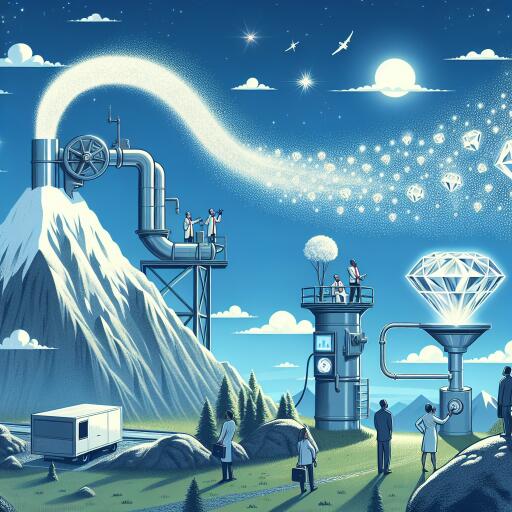
Diamond Dust Injection May Help Reduce Global Warming
Research into innovative approaches to combat climate change has suggested a novel method: injecting diamond dust into the stratosphere. This technique, inspired by the natural cooling effects observed following major volcanic eruptions, could potentially reduce Earth’s temperature by a substantial margin. Scientists envision that deploying five million tons of diamond dust annually could lower global temperatures by as much as 1.6 degrees.
Volcanic eruptions have historically led to noticeable cooling periods on Earth by releasing particles into the atmosphere that reflect sunlight. Inspired by such natural phenomena, researchers believe diamond dust could serve a similar function. When volcanic events occur, they release vast amounts of sulfur dioxide into the atmosphere, leading to the formation of sulfate aerosols. These aerosols reflect solar radiation into space, resulting in a cooling effect. The 1991 eruption of Mount Pinatubo in the Philippines, for example, temporarily cooled the planet by 0.5 degrees.
Geoengineering as a Cooling Mechanism
Faced with the urgent need to address global warming, researchers are exploring various geoengineering initiatives. One of these strategies, known as “stratospheric aerosol injection,” aims to replicate the cooling effects of volcanic eruptions by spraying various aerosols into the atmosphere. This could potentially counteract some of the warming by reducing the amount of solar energy reaching the surface.
However, using sulfur dioxide for this purpose carries significant risks, including the possibility of sulfuric acid rain, harm to the ozone layer, and disturbances to weather patterns. Consequently, scientists are investigating safer and more effective alternatives for aerosols.
Exploring Safer Alternatives
A team of scientists led by Sandro Vattioni in Switzerland has conducted extensive research to find viable compounds that can perform this function without causing environmental harm. Using a sophisticated 3D climate model, the team simulated the effects of different aerosols. The model evaluated seven different compounds including calcite, diamond, and aluminum over a span of 45 years. These simulations were done on supercomputers capable of complex and prolonged processing tasks.
The Potential of Diamond Dust
The findings revealed that diamond particles are extremely effective at reflecting sunlight, remain suspended in the atmosphere for longer periods, and avoid reactions that could lead to acid rain formation. Due to these properties, diamond dust emerged as a strong contender for solar geoengineering. Research indicates that the regular injection of five million tons of diamond dust could feasibly reduce Earth’s temperature by up to 1.6 degrees.
The Cost of Cooling
While diamond dust presents a promising solution, it also comes with a significant financial implication. Implementing this method on a global scale could cost approximately $200 trillion by the turn of the century. That makes it exponentially more expensive—specifically, 2,400 times more—than utilizing sulfur dioxide.
Despite its prohibitive cost, researchers emphasize that diamond dust remains a preferable option to sulfur, which not only holds the risk of acid rain but can also lead to disruptions in climate systems similar to El Niño. The debate on the viability of such costly interventions remains, but the exploration of diamond dust marks a crucial step in identifying innovative ways to address the ever-pressing issue of global warming.
As scientists and policymakers continue to weigh the costs versus the benefits of these geoengineering techniques, the future of our planet may very well depend on the implementation of such daring yet potentially transformative solutions.





Leave a Reply